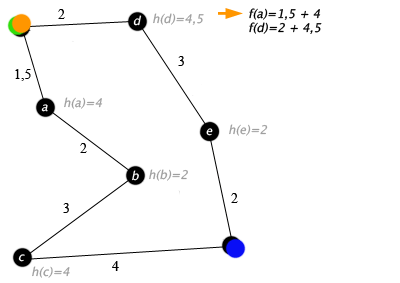Рассмотрим алгоритм A *.
В Google можно найти хороший псевдокод:
function A*(start,goal)
closedset := the empty set // The set of nodes already evaluated.
openset := set containing the initial node // The set of tentative nodes to be evaluated.
came_from := the empty map // The map of navigated nodes.
g_score[start] := 0 // Distance from start along optimal path.
h_score[start] := heuristic_estimate_of_distance(start, goal)
f_score[start] := h_score[start] // Estimated total distance from start to goal through y.
while openset is not empty
x := the node in openset having the lowest f_score[] value
if x = goal
return reconstruct_path(came_from, came_from[goal])
remove x from openset
add x to closedset
foreach y in neighbor_nodes(x)
if y in closedset
continue
tentative_g_score := g_score[x] + dist_between(x,y)
if y not in openset
add y to openset
tentative_is_better := true
elseif tentative_g_score < g_score[y]
tentative_is_better := true
else
tentative_is_better := false
if tentative_is_better = true
came_from[y] := x
g_score[y] := tentative_g_score
h_score[y] := heuristic_estimate_of_distance(y, goal)
f_score[y] := g_score[y] + h_score[y]
Update(closedset,y)
Update(openset,y)
return failure
function reconstruct_path(came_from, current_node)
if came_from[current_node] is set
p = reconstruct_path(came_from, came_from[current_node])
return (p + current_node)
else
return current_node
Что ж, есть одна вещь, которую я не понимаю:ситуация на картинке:

Как A * может измениться с a-> b-> c на a-> d ... ???Ну, я имею в виду, A * начинается с узла и перемещается по узлам.В определенный момент узел имеет более одного соседа, хорошо, A * может следовать по пути, сгенерированному соседом, но в определенный момент он может переключиться ... и вернуться к своим шагам, начиная с предыдущегоузел и переходя на другую дорогу ДАЖЕ, если заброшенный путь не пересекает этот ...
В коде, каково условие, которое позволяет эту среду?